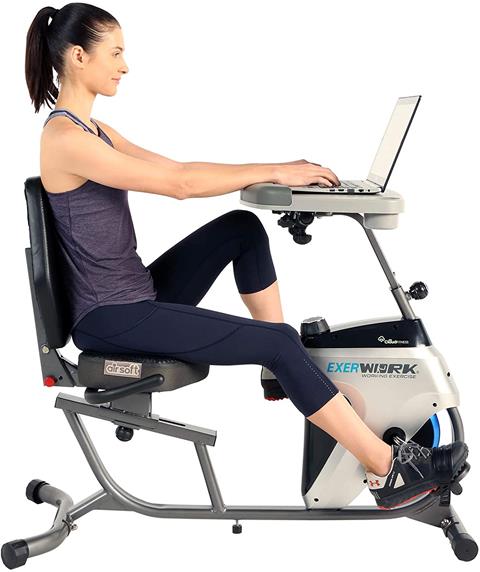 In case you are trying to find an effective and convenient way for indoor workouts, an exercise bike is a solution. What makes the exercise bike appealing over the traditional bikes is the ability to customize features, pre-sets, and resistance adjustment.
In case you are trying to find an effective and convenient way for indoor workouts, an exercise bike is a solution. What makes the exercise bike appealing over the traditional bikes is the ability to customize features, pre-sets, and resistance adjustment.
Furthermore, it is possible to track the miles you have travelled on an exercise bike and the number of calories burned. Typically, bike resistance means how intense the workout is. If the resistance is high, it means the body uses energy during the exercise. In such a scenario, the body burns more calories, and you end up toning the muscles because of the hardship in pushing the pedals.
In most cases, exercise bikes come with up to twenty resistance levels that are simulations of hills and slopes that you can encounter on the traditional bike. The resistance type can either be air-based, brake bases, direct contact, or magnetic. Exercise bikes mostly have a flywheel resistance design. It, therefore, becomes essential to know how to adjust resistance during the workout. The below guide provides step by step detailed information on how to adjust exercise bike resistance.
-
Sit on the bike with the feet on the pedals
Climb the bike face the forward, facing the handlebars. For electric bikes, the screen will be in your front. Place the feet on the pedals such that the toes are almost at the end of the pedals and adjust yourself until you can reach the handles and exercise the pedals easily. Pull the pedal straps and make them a bit tight for your feet not to slide off during pedaling.
-
With your legs extended fully, bend forward
Before setting the resistance, make sure that you are seated comfortably and the posture is right. It is advisable to lean forward to make it easy to reach the front screen and grasp the handlebars firmly.
In most cases, there is an adjustment lever under the seat that you can use to move the seat closer to the handlebars or raise it. Ensure that the bike seat is well positioned so that you can pedal comfortably irrespective of the resistance selected.
-
Rotate the pedals to start the bike
Rotate the pedals while watching the control screen to light up. As long as you are cycling at a low speed, it is impossible to access the resistance settings. Keep cycling for some time without attempting to tweak the settings. However, for mechanical bikes, the resistance controls are available immediately, the cycling starts.
In case the resistance low, keep cycling for a while at a consistent rhythm before altering the settings. In some bikes, turn on the screen by pressing a button and buttons to keep the display on. Some stationary bikes have buttons for various resistance settings, such as hill workouts that are already programmed. If the bike is mechanical, there are no other buttons to set; you only need to keep cycling and prepare for the alteration.

-
Use keypad controls to change the resistance if it is an electric bike.
Look for the resistance controllers with labels underneath the screen. Mostly, they have an arrow shape with markings for both minus plus. To increase the resistance, press the plus arrow, and to decrease it, press the minus arrow.
Nevertheless, the exercise bike will take a few seconds to respond to the settings change, and you need to be patient. Once it responds, you will feel a new resistance kick in, but if otherwise, keep on cycling. Note, when changing resistance, do it gradually so that you can feel how each resistance is and choose the appropriate one correctly.
-
For a mechanical bike, turn the control knob to change resistance
Usually, the resistance control knob in a mechanical exercise bike is on the bike’s stem between the handlebars. To increase the resistance, turn the knob clockwise. In the same way, to decrease the resistance, turn the knob in the counter-clockwise direction.
Importantly, continue pedaling, and after a few seconds, you will feel the bike switch to the new resistance level. Depending on the bike model, you may see labels on the knob, such as numbers, minus, or plus signs. Other models do not feature any label on the control knob.
Conclusion
In conclusion, with exercise bike indoor workouts, one can quickly lose weight and achieve a healthy lifestyle. In all honesty, different levels of resistance have their advantages and disadvantages. For instance, high resistance levels tones up the body and burn calories more quickly, but at the same time, it can lead to injury.
Even in a low resistance, it is still possible to get health benefits if the workout is done for an extended period consistently. If you do not suffer from back pains or knee pains, you should consider a higher resistance. In this regard, it becomes paramount to know the right resistance settings when spinning. Remember to follow the manufacturer’s user manual on how to change the resistance levels.
Related Post:
Top 7 Best Magnetic Spin Bikes of 2022 ( Reviews & Buyer’s Guide )
How Many Times A Week Should I Spin
Top 20 Best Spin Bikes of 2022 (Awesome Indoor Cycle Reviews & Buying Guide)



